Galangin, a novel dietary flavonoid, attenuates metastatic feature via PKC/ERK signaling pathway in TPA-treated liver cancer HepG2 cells
- PMID: 25698902
- PMCID: PMC4332891
- DOI: 10.1186/s12935-015-0168-2
Galangin, a novel dietary flavonoid, attenuates metastatic feature via PKC/ERK signaling pathway in TPA-treated liver cancer HepG2 cells
Abstract
Background: Galangin (3,5,7-trihydroxyflavone) is a flavonoid compound found in high concentration in lesser galangal. The objective of this study was to investigate the ability of galangin to inhibit 12-O-tetradecanoylphorbol-13-acetate (TPA)-induced the invasion and metastasis of HepG2 liver cancer cells.
Results: First, using a cell-matrix adhesion assay, immunofluorescence assay, transwell-chamber invasion/migration assay, and wound healing assay, we observed that galangin exerted an inhibitory effect on TPA-induced cell adhesion, morphology/actin cytoskeleton arrangement, invasion and migration. Furthermore, the results of gelatin zymography and reverse transcriptase polymerase chain reaction (RT-PCR) assays showed that galangin reduced the TPA-induced enzyme activity of matrix metalloproteinase-2 (MMP-2) and matrix metalloproteinase-9 (MMP-9) in HepG2 cells; moreover, the messenger RNA level was downregulated. We also observed through a Western blotting assay that galangin strongly inhibited the TPA-induced protein expressions of protein kinase Cα (PKCα), protein kinase Cδ (PKCδ), phosphorylated extracellular signal-regulated kinase 1/2 (ERK1/2), the phospho-inhibitor of kappaBα (phospho-IκBα), c-Fos, c-Jun, and nuclear factor kappa B (NF-κB). Next, galangin dose-dependently inhibited the binding ability of NF-κB and activator protein 1 (AP-1) to MMP-2/MMP-9 promoters, respectively, resulting in the suppression of MMP-2/MMP-9 enzyme activity.
Conclusions: The results revealed that galangin effectively inhibited the TPA-induced invasion and migration of HepG2 cells through a protein kinase C/extracellular signal-regulated kinase (PKC/ERK) pathway. Thus, galangin may have widespread applications in clinical therapy as an anti-metastatic medicament.
Keywords: ERK; Galangin; Invasion; MMP-2; MMP-9; Migration; PKC-α; TPA.
Figures
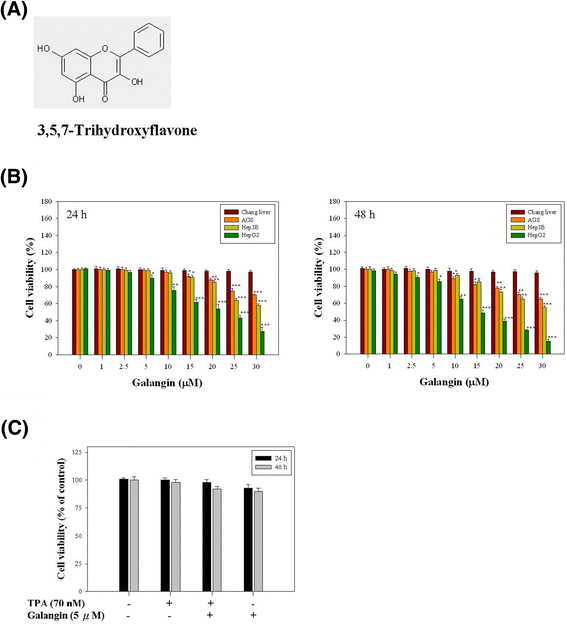
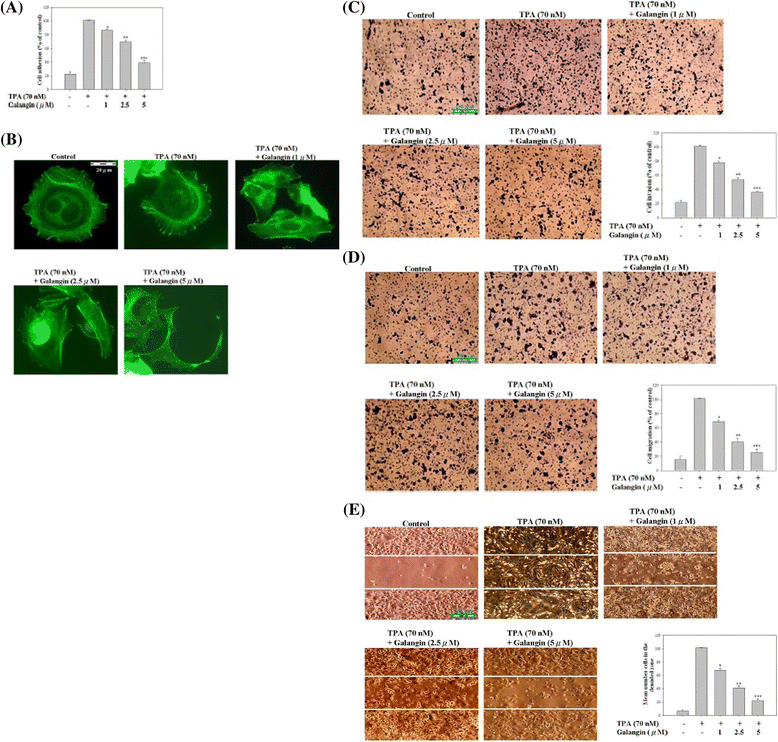
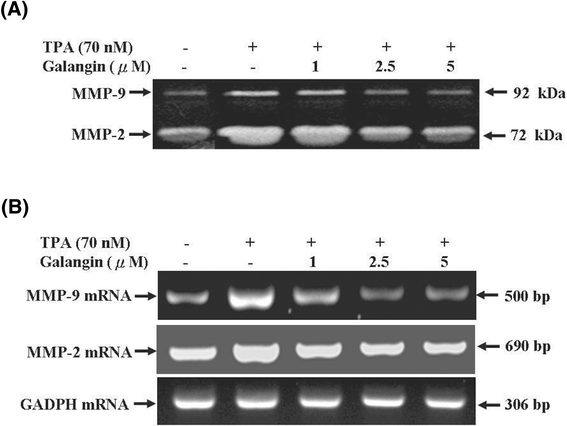
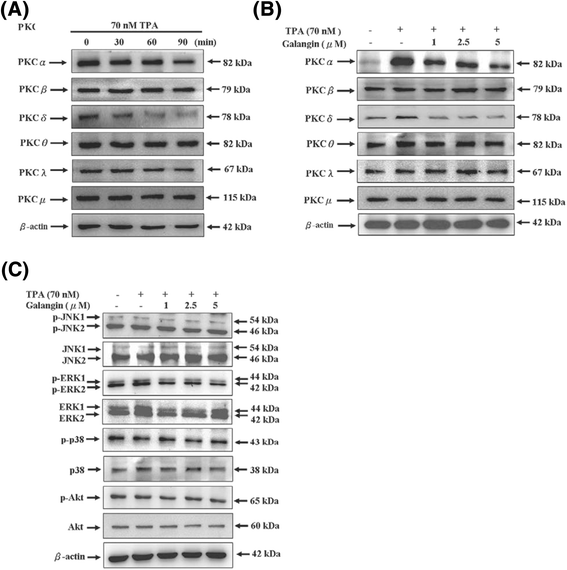
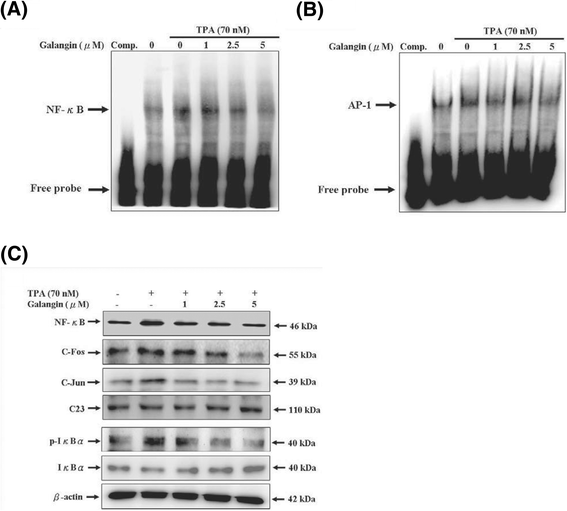
Similar articles
-
Suppression of 12-O-tetradecanoylphorbol-13-acetate-induced MCF-7 breast adenocarcinoma cells invasion/migration by α-tomatine through activating PKCα/ERK/NF-κB-dependent MMP-2/MMP-9 expressions.Cell Biochem Biophys. 2013 May;66(1):161-74. doi: 10.1007/s12013-012-9465-8. Cell Biochem Biophys. 2013. PMID: 23114726
-
alpha-Mangostin, a novel dietary xanthone, suppresses TPA-mediated MMP-2 and MMP-9 expressions through the ERK signaling pathway in MCF-7 human breast adenocarcinoma cells.J Food Sci. 2010 Jan-Feb;75(1):H13-23. doi: 10.1111/j.1750-3841.2009.01407.x. J Food Sci. 2010. PMID: 20492173
-
12-O-tetradecanoylphorbol-13-acetate-induced invasion/migration of glioblastoma cells through activating PKCalpha/ERK/NF-kappaB-dependent MMP-9 expression.J Cell Physiol. 2010 Nov;225(2):472-81. doi: 10.1002/jcp.22226. J Cell Physiol. 2010. PMID: 20458747
-
Plumbagin inhibits TPA-induced MMP-2 and u-PA expressions by reducing binding activities of NF-kappaB and AP-1 via ERK signaling pathway in A549 human lung cancer cells.Mol Cell Biochem. 2010 Feb;335(1-2):181-93. doi: 10.1007/s11010-009-0254-7. Epub 2009 Sep 21. Mol Cell Biochem. 2010. PMID: 19768635
-
Orientin inhibits invasion by suppressing MMP-9 and IL-8 expression via the PKCα/ ERK/AP-1/STAT3-mediated signaling pathways in TPA-treated MCF-7 breast cancer cells.Phytomedicine. 2018 Nov 15;50:35-42. doi: 10.1016/j.phymed.2018.09.172. Epub 2018 Sep 18. Phytomedicine. 2018. PMID: 30466990
Cited by
-
Flavonoid-Conjugated Gadolinium Complexes as Anti-Inflammatory Theranostic Agents.Antioxidants (Basel). 2022 Dec 15;11(12):2470. doi: 10.3390/antiox11122470. Antioxidants (Basel). 2022. PMID: 36552678 Free PMC article.
-
SUMOylation of annexin A6 retards cell migration and tumor growth by suppressing RHOU/AKT1-involved EMT in hepatocellular carcinoma.Cell Commun Signal. 2024 Apr 2;22(1):206. doi: 10.1186/s12964-024-01573-2. Cell Commun Signal. 2024. PMID: 38566133 Free PMC article.
-
SP6616 as a new Kv2.1 channel inhibitor efficiently promotes β-cell survival involving both PKC/Erk1/2 and CaM/PI3K/Akt signaling pathways.Cell Death Dis. 2016 May 5;7(5):e2216. doi: 10.1038/cddis.2016.119. Cell Death Dis. 2016. PMID: 27148689 Free PMC article.
-
Galangin Improved Non-Alcoholic Fatty Liver Disease in Mice by Promoting Autophagy.Drug Des Devel Ther. 2020 Aug 19;14:3393-3405. doi: 10.2147/DDDT.S258187. eCollection 2020. Drug Des Devel Ther. 2020. PMID: 32884242 Free PMC article.
-
A Penicillin Derivative Exerts an Anti-Metastatic Activity in Melanoma Cells Through the Downregulation of Integrin αvβ3 and Wnt/β-Catenin Pathway.Front Pharmacol. 2020 Feb 25;11:127. doi: 10.3389/fphar.2020.00127. eCollection 2020. Front Pharmacol. 2020. PMID: 32158394 Free PMC article.
References
LinkOut - more resources
Full Text Sources
Other Literature Sources
Research Materials
Miscellaneous

